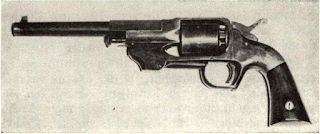Listed among the “Pistols” obtained for the war is
$9,130.50. Of these, 198 were bought from William
A solid and strongly built gun, the Allen & Wheelock
 |
| Big Allen's revolver used trigger guard hinging forward to |
A solid and strongly built gun, the Allen & Wheelock

Comments
Post a Comment